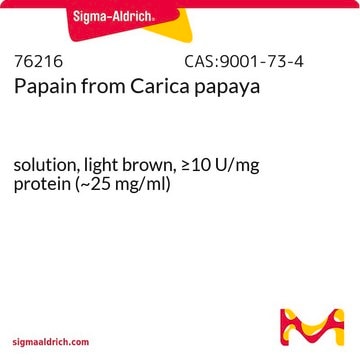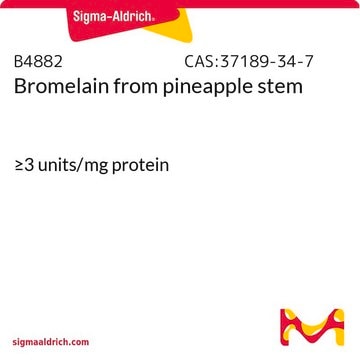10108014001
Roche
Papain
from Carica papaya
Synonim(y):
cystein protease, papain
Zaloguj sięWyświetlanie cen organizacyjnych i kontraktowych
About This Item
Polecane produkty
pochodzenie biologiczne
papaya
Poziom jakości
Postać
suspension
aktywność właściwa
30 U/mg
~30 units/mg protein (At 25 °C with BAEE as the substrate.)
masa cząsteczkowa
23 kDa
opakowanie
pkg of 10 mL (100 mg)
producent / nazwa handlowa
Roche
stężenie
10-100 mg/mL
optymalne pH
6.0-7.0
Warunki transportu
wet ice
Powiązane kategorie
Opis ogólny
Papain is a cysteine protease of the papain family. It is a single chain protein. The molecular weight of papain is 23 kDa. Papain is composed of two structural domains and a cleft between them, which consists of the active site.
Zastosowanie
Papain has been used in the digestion of various brain cells.
Use Papain for the complete proteolytic cleavage of proteins, limited hydrolysis of native immunoglobulins, and tissue dissociation (together with collagenase, esterase, and trypsin). The enzyme solubilizes integral membrane proteins and produces glycopeptides from purified proteoglycans. The addition of cysteine (approximately 0.5% [w/v]) is essential for enzyme activity.
Działania biochem./fizjol.
Papain exhibits proteolytic activity against amide links, amino acid esters, peptides, proteins. It mainly cleaves peptide bonds containing amino acids such as lysine, arginine and residues succeeding phenylalanine. It can catalyze several reactions, such as hydrolysis, transferase action, specificity and acyl-enzyme intermediate.
Cechy i korzyści
Inhibitors: SH-blocking reagents, iodoacetic acid, iodoacetamide, TPCK, TLCK, leupeptin, a2-macroglobulin, E-64, PMSF, and antipain, Hg2+, and other heavy metals
Postać fizyczna
Suspension, crystalline, nonsterile
Uwaga dotycząca przygotowania
Working concentration: 0.05 to 0.5 mg/ml
Przechowywanie i stabilność
Store at 2 to 8 °C. (a decrease in activity of 20% may occur within 6 months)
Inne uwagi
For life science research only. Not for use in diagnostic procedures.
Kod klasy składowania
12 - Non Combustible Liquids
Klasa zagrożenia wodnego (WGK)
nwg
Temperatura zapłonu (°F)
does not flash
Temperatura zapłonu (°C)
does not flash
Certyfikaty analizy (CoA)
Poszukaj Certyfikaty analizy (CoA), wpisując numer partii/serii produktów. Numery serii i partii można znaleźć na etykiecie produktu po słowach „seria” lub „partia”.
Masz już ten produkt?
Dokumenty związane z niedawno zakupionymi produktami zostały zamieszczone w Bibliotece dokumentów.
Klienci oglądali również te produkty
John S. White and Dorothy C. White
Source Book of Enzymes null
Spatiotemporal ablation of CXCR2 on oligodendrocyte lineage cells: Role in myelin repair
Liu L, et al.
Neurology? neuroimmunology & neuroinflammation, 2(6), e174-e174 (2015)
Yaser Hosny Ali Elewa et al.
International journal of molecular sciences, 22(13) (2021-07-03)
Recently, we clarified the function of mediastinal fat-associated lymphoid clusters (MFALCs) in the progression of several respiratory diseases. However, their role has not yet been identified in the lung asthmatic condition. Hence, we compared the immune cells in lung and
Monica Tambalo et al.
Development (Cambridge, England), 147(6) (2020-02-26)
Segmentation of the vertebrate hindbrain leads to the formation of rhombomeres, each with a distinct anteroposterior identity. Specialised boundary cells form at segment borders that act as a source or regulator of neuronal differentiation. In zebrafish, there is spatial patterning
LIM Kinase, a Newly Identified Regulator of Presynaptic Remodeling by Rod Photoreceptors After Injury.
Wang W and Townes-Anderson E
Investigative Ophthalmology & Visual Science, 56(13), 7847-7858 (2015)
Nasz zespół naukowców ma doświadczenie we wszystkich obszarach badań, w tym w naukach przyrodniczych, materiałoznawstwie, syntezie chemicznej, chromatografii, analityce i wielu innych dziedzinach.
Skontaktuj się z zespołem ds. pomocy technicznej








